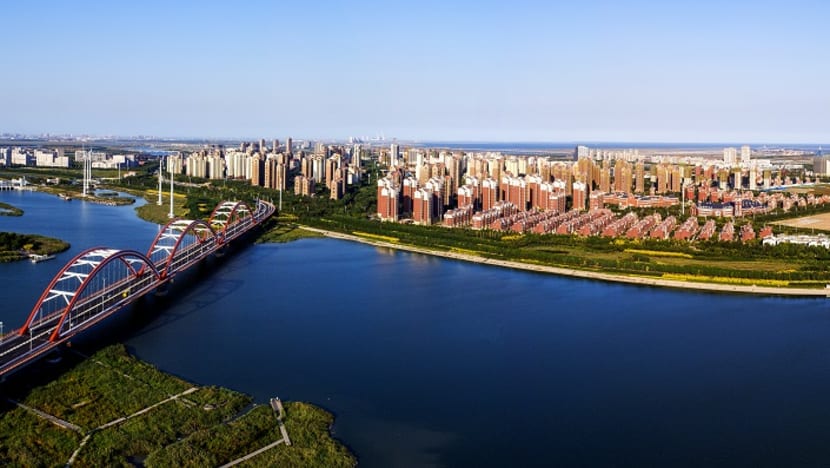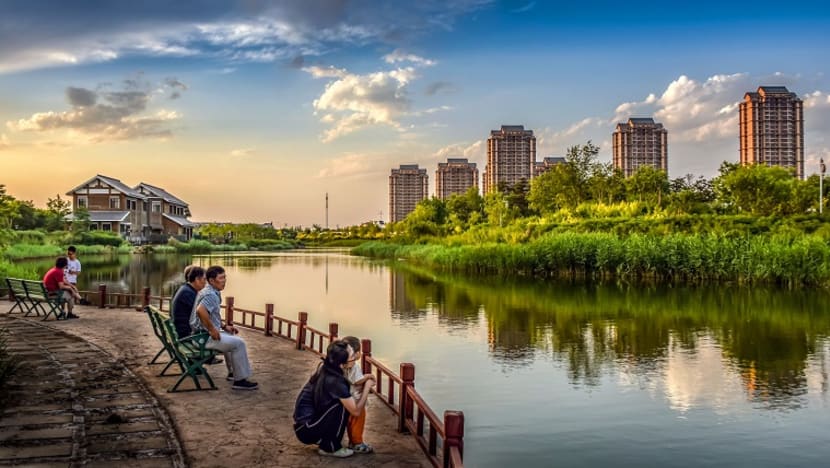Singapore and China have agreed to deepen cooperation to make the Sino-Singapore Tianjin Eco-City greener and more sustainable, said Singapore’s Ministry of National Development (MND) on Wednesday (Dec 29, 2021).
National Development Minister Desmond Lee announced during the 13th Sino-Singapore Tianjin Eco-City Joint Steering Council Meeting on Wednesday that the National Parks Board of Singapore (NParks) and the Tianjin Eco-City Administrative Committee of China have signed a memorandum of understanding on a collaboration to enhance the Eco-City.
It was once a desolate, toxic, uninhabitable wasteland. Today, Tianjin has been transformed into a cool, breathing liveable city. Click on VIDEO to go inside the Tianjin Eco-City to see how this bilateral project between China and Singapore has transformed over the past decade. Home to thousands of families and businesses, it’s now setting new standards for modern living in China and beyond.
Transforming a former wasteland into Tianjin Eco-City, 22 Jan 2019
Parks connecting the city’s green spaces
There are plans to further weave greenery into the built environment and bring nature closer to the Eco-City’s residents and visitors, MND said in a media release.
There will also be programmes to promote awareness of the benefits of greenery and nurture community stewardship of the city’s natural environment.
Under the MOU, both sides will jointly plan, design and develop features such as a 27-hectare green belt, 18km of park connectors connecting the city’s green spaces, as well as pocket parks at street corners in the central area of the Eco-City.
Mr Lee said that the collaboration was established 13 years ago with the vision of making the Eco-City “a replicable model for sustainable development for cities”.
The number of people living or working in the Eco-City has grown from 20,000 in 2014 to more than 120,000 today.
“Over the years, it has successfully transformed from a barren land to a thriving eco-city. The Eco-City’s experience is now even more relevant given the global commitment to reduce carbon emissions, including our launch of the Singapore Green Plan 2030 and China’s plans to achieve carbon neutrality by 2060.
“In the next phase of the Eco-City’s development, we will aim higher and elevate the Eco-City into a greener, smarter and more sustainable city,” he said.


Mr Lee said that “good progress” has been made by both nations in the Eco-City project.
“At a time where there were no precedents or established standards for the management of polluted water bodies in China, we rehabilitated a former wastewater pond to become what we now call Jing Lake, right at the heart of the city,” he said.
The Eco-City’s success at Jing Lake has been replicated in other areas in China, MND said.
The city’s environmental rehabilitation initiatives have been a “critical step” to developing networks of inter-connected water and greenery systems, Mr Lee said.
“We now see residents enjoying beautiful and clean rivers, lush greenery and an extensive network of parks and open spaces.
“With this MOU, we will continue to push boundaries to further enhance the integration of nature with the built environment and create a distinctive Eco-City.”

Smart and low carbon development
Singapore and China will also expand their efforts in the smart and low carbon development of the Eco-City.
In Keppel Land’s residential developments in the Eco-City, smart technology applications in homes and estates could, for instance, allow elderly or disabled residents to indicate their needs and connect them with community volunteers.
The real estate company has also opened a smart and low-carbon mall featuring a cloud-based service platform, energy saving technology and photovoltaics and a solar hot water system to harness solar energy.
Keppel Land will also scale up the use of smart technologies in a precinct of the Eco-City’s northern district.
“Singapore and China’s innovations and new ideas in the Eco-City will continue to be shared and scaled jointly,” MND said in its statement.
“Both countries will continue to work together to realise our vision of the Eco-City as a green, smart and sustainable Eco-City in the next bound of development.”
SOURCE: Channel News Asia, 29 Dec 2021.
https://www.channelnewsasia.com/singapore/tianjin-eco-city-singapore-china-sign-mou-sustainable-2406081